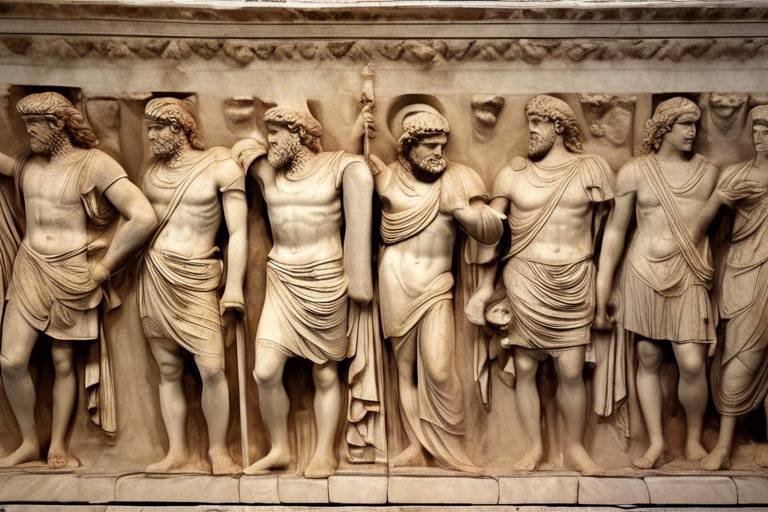The Forgotten Achievements of the Hellenistic Period
The Hellenistic period, often overshadowed by the grandeur of ancient Greece and the Roman Empire, holds a treasure trove of forgotten achievements waiting to be rediscovered. This era, following the conquests of Alexander the Great, witnessed a fusion of cultures that sparked remarkable advancements in various fields, leaving an indelible mark on history. While the legacy of the Hellenistic period is often overlooked, its impact on art, science, philosophy, and more is undeniable.

Artistic Innovations
Exploring the lesser-known advancements and contributions of the Hellenistic era, which followed the reign of Alexander the Great and greatly influenced art, science, philosophy, and more.
During the Hellenistic period, a remarkable fusion of artistic styles emerged, blending the traditional Greek aesthetic with influences from the East. This cultural exchange gave rise to innovative art forms and architectural designs that captivated audiences across the ancient world.
One of the most notable artistic innovations of this era was the development of realistic portrayals in sculpture. Artists strived for greater naturalism and emotional expression in their works, moving away from the idealized forms of earlier Greek art. Sculptures like the famous Laocoon and His Sons showcased intricate details and dynamic poses, conveying a sense of movement and drama.
Moreover, Hellenistic architects introduced new structural techniques and design elements in their buildings. The use of grandiose columns, elaborate facades, and intricate decorations became characteristic of Hellenistic architecture, influencing future architectural styles for centuries to come.
Artistic innovation was not limited to sculptures and buildings; it extended to other art forms as well. Hellenistic artists experimented with new painting techniques, creating vibrant and detailed artworks that captured scenes from mythology, everyday life, and historical events with unparalleled realism.
The artistic achievements of the Hellenistic period not only reflected the cultural diversity of the time but also set the stage for artistic developments in the centuries that followed, leaving a lasting impact on the world of art and aesthetics.
- What were some key characteristics of Hellenistic art?
- How did Hellenistic architecture differ from earlier Greek architecture?
- What impact did Hellenistic art have on future artistic developments?
Hellenistic art was characterized by a departure from the idealized forms of classical Greek art, embracing naturalism, emotional expression, and intricate details in sculptures and paintings.
Hellenistic architecture incorporated grandiose columns, elaborate facades, and intricate decorations, showcasing a more ornate and decorative style compared to the simpler designs of classical Greek architecture.
The artistic innovations of the Hellenistic period laid the foundation for realistic portrayals in art, architectural advancements, and experimentation with new techniques, influencing artistic styles in the following centuries.

Scientific Progress
Exploring the lesser-known advancements and contributions of the Hellenistic era, which followed the reign of Alexander the Great and greatly influenced art, science, philosophy, and more.
Discovering the unique art forms and architectural styles that emerged during the Hellenistic period, blending Greek traditions with influences from the East.
Uncovering the significant advancements in fields such as astronomy, mathematics, and medicine achieved by Hellenistic scholars like Euclid, Aristarchus, and Hippocrates.
Exploring the groundbreaking observations and theories in astronomy made by Hellenistic astronomers, including the heliocentric model proposed by Aristarchus.
Examining the mathematical achievements of Hellenistic mathematicians like Euclid, whose work laid the foundation for modern geometry.
Delving into the philosophical ideas and schools of thought that flourished during the Hellenistic period, such as Stoicism, Epicureanism, and Skepticism.
Understanding the principles of Stoicism and its emphasis on virtue, reason, and living in harmony with nature, as promoted by philosophers like Zeno of Citium.
Exploring the teachings of Epicurus, who advocated for a life of pleasure, tranquility, and the pursuit of knowledge, challenging traditional Greek views on happiness.
Reflecting on how the achievements of the Hellenistic period continue to shape our understanding of art, science, philosophy, and culture today.
The Hellenistic period was a time of remarkable scientific progress, with scholars making significant advancements in various fields that laid the foundation for future discoveries. One of the most notable areas of achievement was in astronomy, where Hellenistic astronomers like Aristarchus revolutionized our understanding of the cosmos. By proposing the heliocentric model, which placed the Sun at the center of the solar system, Aristarchus challenged the prevailing geocentric view and paved the way for the Copernican revolution centuries later.

Astronomical Discoveries
The Hellenistic period marked a significant era of astronomical discoveries that revolutionized our understanding of the cosmos. Hellenistic astronomers, such as Aristarchus of Samos, made groundbreaking observations and proposed theories that challenged traditional beliefs and laid the foundation for modern astronomy. One of the most notable contributions was the heliocentric model, which suggested that the Earth and planets revolve around the Sun, a concept far ahead of its time.
Aristarchus, known for his bold ideas and mathematical prowess, argued for a heliocentric universe long before Copernicus reintroduced the concept in the 16th century. His calculations and theories paved the way for future astronomers to explore the dynamics of celestial bodies and the structure of the solar system. By questioning the prevailing geocentric view, Aristarchus sparked a scientific revolution that continues to inspire astronomers and cosmologists to this day.
The Hellenistic period also witnessed advancements in observational astronomy, with astronomers like Hipparchus developing methods to accurately measure the positions of stars and planets. Their meticulous observations and mathematical calculations led to the creation of star catalogs and the refinement of astronomical instruments, enabling future generations to navigate the night sky with precision.
Moreover, the Hellenistic astronomers made significant progress in understanding the motion of celestial bodies and predicting astronomical events. Their studies on the movements of planets, lunar phases, and eclipses laid the groundwork for the development of modern astronomy and the formulation of laws governing the universe. By exploring the mysteries of the cosmos, Hellenistic astronomers expanded human knowledge and set the stage for centuries of scientific inquiry and discovery.

Mathematical Contributions
During the Hellenistic period, the realm of mathematics experienced a renaissance, with scholars making significant contributions that laid the groundwork for modern mathematical principles. One of the most prominent figures in Hellenistic mathematics was Euclid, known for his monumental work "Elements." This treatise became the quintessential textbook on geometry for centuries to come, presenting a systematic approach to the subject and introducing foundational concepts such as axioms and proofs.
Euclid's "Elements" comprised 13 books covering various aspects of geometry, including the properties of shapes, angles, and proportions. His deductive method of reasoning revolutionized the way mathematics was studied and taught, emphasizing logical arguments to establish mathematical truths. Euclid's geometric principles, such as the Pythagorean theorem and the concept of parallel lines, became fundamental in shaping the discipline of mathematics as we know it today.
Furthermore, Hellenistic mathematicians made significant strides in the understanding of number theory and mathematical analysis. Scholars like Apollonius of Perga contributed to the study of conic sections, while Archimedes made groundbreaking discoveries in calculus and geometry. Their innovative approaches to problem-solving and mathematical inquiry paved the way for future developments in mathematics and science.

Philosophical Developments
During the Hellenistic period, a rich tapestry of philosophical ideas emerged, shaping the intellectual landscape of the era. Philosophers of diverse schools of thought such as Stoicism, Epicureanism, and Skepticism offered unique perspectives on the nature of existence, ethics, and the pursuit of happiness. These philosophical developments were not just abstract theories but practical guides for individuals seeking meaning and fulfillment in a rapidly changing world.
Stoicism, founded by Zeno of Citium, emphasized the cultivation of virtue, rationality, and acceptance of fate. It taught that individuals should focus on what is within their control and let go of what is not, leading to a state of inner peace and resilience in the face of adversity. Stoicism's influence extended beyond the Hellenistic period, resonating with later thinkers and even finding relevance in modern cognitive-behavioral therapy.
In contrast, Epicureanism, championed by Epicurus, advocated for a life of simplicity, pleasure, and the pursuit of knowledge. Contrary to the prevailing Greek belief that happiness stemmed from external achievements, Epicureanism posited that true contentment arose from inner tranquility and the avoidance of unnecessary desires. By promoting a philosophy centered on personal fulfillment and moderation, Epicurus challenged societal norms and redefined the concept of happiness.
Skepticism, represented by thinkers like Pyrrho of Elis, questioned the possibility of attaining true knowledge and advocated for suspension of judgment in the face of uncertainty. Skeptics believed that by acknowledging the limitations of human perception and reasoning, individuals could achieve a state of intellectual humility and open-mindedness. This philosophical stance encouraged critical thinking and a willingness to explore different perspectives without dogmatic adherence to any single belief system.

